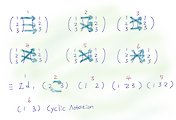다음 포스팅은 https://youtu.be/na0YYLJLWeQ 의 영상에서 작성한 노트의 핵심을 정리한 것입니다. 여러 오탈자 및 수정 사항들이 있을 수 있습니다. 노트 내용에 대한 디테일한 설명들은 영상을 참고하시길 바랍니다.
20191025 Normal subgp - 2.
Recall that given sets $A, B, C \subseteq A, D \subseteq B$,
$f: A \rightarrow B$ a fn.
Then 1) $f^{-1}(f(C)) \geq C$
2)$f^{-1}(f(c))=c$ if $f$ is $1-1$ Sometimes, even though $f$ is not $1-1, f^{-1}(f(c))=C$.
Theorem 1. Let $f: G \rightarrow G'$ be a group homomorphism.
Assume kerf $\subseteq H \leq G$ then $f^{\prime}(f(H))=H$
Proof.
$
\begin{aligned}
& \text { ⊆: Let } x \in f^{\prime}(f(H))=\{y \mid f(y) \in \underline{\mid f(H)} \\
& \quad \Leftrightarrow f(x) \in f(H)
\end{aligned}
$
$\Leftrightarrow \exists$ h$\in$ H s.t $f(x)=f(h)$.
$
\begin{aligned}
\Leftrightarrow f(x) f(h)^{-1} & =e \\
f\left(x h^{-1}\right) & \Rightarrow x h^{-1} \in k e r f \subseteq H . \\
& \Rightarrow \exists h^{\prime} \in H \text { set } x h^{-1}=h^{\prime} \\
& \Rightarrow x=h h^{\prime} \in H
\end{aligned}
$
Hence if $x \in f^{-1}(f(H))$ then $x \in H$.
Theorem 2. Let $\phi: G \longrightarrow G^{\prime}$ be a group homomorphism and onto.
Consider $A:=\{H \subseteq G \mid$ ker$\phi$ $\subseteq H \leq G\}$
$\beta:=\left\{H^{\prime} \subseteq G^{\prime} \mid H^{\prime} \leq G^{\prime}\right\} \text {. }$
Define $\Phi: A \rightarrow \beta$
$H \longmapsto \phi(H)$
Then $\Phi$ is 1-1, onto.
i.e, if $H^{\prime} \in B$, then $\Phi^{-1}\left(H^{\prime}\right)=\phi^{-1}\left(H^{\prime}\right)$.
proof. $\forall H \leq G, \phi(H) \leq G^{\prime}$. Hence $\Phi$ is well-defined
claim: $\Phi$ is 1-1
Let $\Phi\left(H_{1}\right)=\Phi\left(H_{2}\right) . \Leftrightarrow \phi\left(H_{1}\right)=\varnothing\left(H_{2}\right)$
by Than 1,
$
\left\{\begin{array}{l}
\phi^{-1}\left(\phi\left(H_{1}\right)\right)=H_{1} \\
\phi^{-1}\left(\phi\left(H_{2}\right)\right)=H_{2}
\end{array}\right.
$
i.e, $\mathrm{H}_{1}=\mathrm{H}_{2}$
claim: $\Phi$ is onto.
Take any $H^{\prime} \leq G^{\prime}$
(We need to find $H \subseteq G$ s.t ker $\phi \subseteq H \subseteq G$ and
$\left.\phi(H)=H^{\prime}\right)$
choose $H_{0}=\phi^{-1}\left(H^{\prime}\right)$
Note that $\phi^{-1}\left(H^{\prime}\right) \leq G$ and ker $\left.\phi \subseteq \phi^{-1} H^{\prime}\right)$
r.If $x \in k \in \operatorname{ker}, \phi(x)=e_{G} \in H^{\prime}$ i. $e_{}, x \in \phi^{-1}\left(H^{\prime}\right)$,
Thus $H_{0} \in A$.
By Theorem 1, $\phi^{-1}\left(\phi\left(H_{0}\right)\right)=H_{0}$.
By surjectivity of $\phi, \phi\left(\phi^{-1}\left(H^{\prime}\right)\right)=H^{\prime}$
Thus $\Phi\left(H_{0}\right) \stackrel{\operatorname{def}}{=} \phi\left(H_{0}\right)=H^{\prime}(U)$
Thus $\Phi^{t}$ is well-defined and $\Phi^{-1}\left(H^{\prime}\right)=H_0$.
Remark. Let $\phi: G \rightarrow G$ be a group homomorphism.
$\begin{aligned}
& \widetilde{A}:=\{H \subseteq G|| \operatorname{ker} \phi \subseteq H \unlhd G\} \\
& \left.\tilde{B}:=\{ H^{\prime} \subseteq G^{\prime}\left|H^{\prime} \unlhd G\right|\right\}
\end{aligned}$
Define $\Phi: \tilde{A} \longrightarrow \tilde{\beta}$
$H \longmapsto \phi(H)$
$\operatorname{Ker} \phi \subseteq H \unlhd G \Rightarrow \phi(H) \unlhd \phi(G) \stackrel{\phi \text { onto }}{=} G^{\prime}$
This shows $\Phi$ is well-defined.
By the Similar argument, $\Phi$ is H, onto.
i.e., $\exists$ 1-1 Correspondence between
$
\begin{aligned}
\{H \subseteq G \mid ker \phi \subseteq H \unlhd G\} & \left.\longrightarrow S^{\prime} H^{\prime} \subseteq G^{\prime} \mid H^{\prime} \unlhd G^{\prime}\right\} \\
H | & \longrightarrow \phi(H) .
\end{aligned}
$
provided $\phi: G \rightarrow$ G' subj g.p.homo.
Definition. We say a group $G$ is simple if there is no normal subgp except {e} and $G$.
Definition. $M \unlhd G$ is a maximal normal subgp $M$ of $G$.
if $M \neq G$, and $\exists N \subseteq G$ St $M \subseteq N \unlhd G$
$\Rightarrow N=G \text {. }$
Proposition. Let $M \unlhd G$.
G/M is simple if and only if M is a maximal nomal subgp
Lemma. Let $N \unlhd G, \pi: G \longrightarrow G / N$
$g \longmapsto g N$
$(k e r \pi=\{g \in G \mid g N=N\}=N)$.
Then
$\Phi:\{H \subseteq G \mid \operatorname{ker} \pi \subseteq H \unlhd G\}$
$
\longrightarrow\left\{H^{\prime} \subseteq G / N \mid H^{\prime} \unlhd G / N\right\} \begin{gathered}
\text { is } H, \\
\text { onto }
\end{gathered}
$
proof. If follows from the above rmk.
{(normal) subgps of G containing N}
$\underset{\text { cowespondence }}{\stackrel{1-1}{\longrightarrow}}$ (normal) subgp of G/N\}
Proof of plop $\pi: G \rightarrow G / M$
$g \longmapsto g M$
Let G/M be simple
i.e, there are only two normal subgps
$\{e\}=M$ and $G / M$ of $G / M$,
By the 1-1 correspondence
there are only two nomal subgps of $G$
Containing $M \Rightarrow M, G$.
This means $M$ is a maxmal normal subgp of $G$.
'기초부터 대학원 수학까지, 추상대수학' 카테고리의 다른 글
| 27. 추상대수학에서 선형대수학으로 : 대칭군과 행렬식의 정의 (0) | 2023.09.03 |
|---|---|
| 26. 추상대수학 (g) 제1,2,3 동형정리 (0) | 2023.08.31 |
| 24. 추상대수학 (e) 정규부분군의 정의 (0) | 2023.08.23 |
| 23. 추상대수학 (d) 군작용과 케일리 정리 (0) | 2023.08.18 |
| 22. 추상대수학 (c) 잉여군과 라그랑지 정리 (0) | 2023.08.15 |
